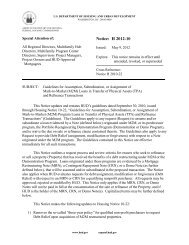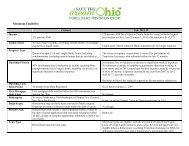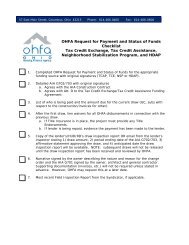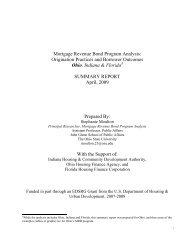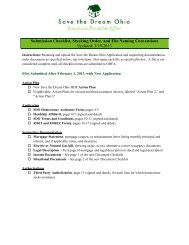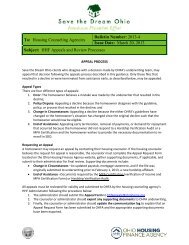lis 217 stemming the tide - LISC
lis 217 stemming the tide - LISC
lis 217 stemming the tide - LISC
- No tags were found...
Create successful ePaper yourself
Turn your PDF publications into a flip-book with our unique Google optimized e-Paper software.
StrategiesAdvocates brought <strong>the</strong> owner to <strong>the</strong> negotiatingtable on <strong>the</strong> basis of HUD's existing FlexibleSubsidy contract and Use Agreement, whichrequired <strong>the</strong> owner to operate <strong>the</strong> project as221(d)(3) housing through <strong>the</strong> original mortgageterm and to secure HUD's consent to prepayment.HUD refused to approve <strong>the</strong> prepaymentunless <strong>the</strong> project remained affordable tolow-income families through 2010, <strong>the</strong> mortgagematurity date. 38 However, HUD stated that<strong>the</strong>re were no federal rules preventing <strong>the</strong>owner from opting out of <strong>the</strong> Section 8 contract.The city <strong>the</strong>n asserted claims under <strong>the</strong> project’sChapter 121A contract, which referenced <strong>the</strong>owner’s promise in <strong>the</strong> original application to constructand maintain a Section 221(d)(3) project withSection 8 assistance for 40 years. Based on <strong>the</strong>sedocuments, <strong>the</strong> City argued that <strong>the</strong> owner could nei<strong>the</strong>rprepay nor opt out through 2010.The owner agreed to explore HUD's new Mark-Up-to-Market initiative as an alternative but quickly discoveredtwo hurdles. First, because <strong>the</strong> Section 8 contractwas underutilized, <strong>the</strong> financial benefits availablefrom Mark-Up-to-Market were limited. Second,<strong>the</strong> existing low- and moderate-income use restrictionsassociated with <strong>the</strong> City's 121A contract, andwith HUD's Flexible Subsidy loan, constituted an eligibilitybarrier. HUD would have to provide a waiverallowing <strong>the</strong> owner to participate in <strong>the</strong> Mark-Up-to-Market program. 39 The same restrictions would effectivelycap <strong>the</strong> market rents, thus reducing <strong>the</strong> level ofbenefits available from this program. Just how <strong>the</strong> cityinterpreted its 121A use restriction to HUD thusbecame critical to <strong>the</strong> owner's ability to take advantageof Mark-Up-to-Market incentives.OutcomeUltimately, <strong>the</strong> City succeeded in using its 121Arestrictions to extend affordability. The finalpackage included <strong>the</strong> following provisions:• All units covered by <strong>the</strong> Section 8 contract(338), to <strong>the</strong> extent actually occupied by subsidy-eligiblehouseholds, were marked up to<strong>the</strong> effective BMIR limit (rents deemed affordableat 30 percent of <strong>the</strong> maximum BMIRincome level, or 95 percent of <strong>the</strong> AreaMedian Income (AMI)). Underutilized Section8 slots will be marked-up upon turnover,when <strong>the</strong> units are reoccupied by Section 8-eligible households. The owner is obligated torenew and fully utilize <strong>the</strong> Section 8 contractthroughout <strong>the</strong> term of <strong>the</strong> new use agreement.• If project-based Section 8 is discontinued, <strong>the</strong>owner must accept vouchers at <strong>the</strong> maximumPHA payment standard. Upon turnover, <strong>the</strong>units will be rented at a stricter affordabilitystandard, 30 percent of 80 percent of AMI• While prepayment is permitted by <strong>the</strong> settlement,all 166 non-Section 8 units must beheld harmless at <strong>the</strong> OCAF-adjusted BMIRrents (for current and future tenants). Futureoccupancy will be restricted to householdswith incomes at or below 80 percent of AMI,vs. <strong>the</strong> current limit of 95 percent of AMI.• The owner must complete capital improvementsaccording to an agreed-upon schedule.• The term of <strong>the</strong> new use agreement is 20years, through 2020.• The city is a party to <strong>the</strong> new use agreementand has enforcement powers, along with HUDand <strong>the</strong> project residents.Following this precedent, Chapter 121A contractrequirements have been used by <strong>the</strong> BostonRedevelopment Authority to maintain affordabilityin at least a half dozen projects. InBoston, every 121A project that seeks to participatein <strong>the</strong> discretionary Mark-Up-to-Marketprogram is required by <strong>the</strong> BRA to execute along-term Section 8 contract that is at leastcoterminous with <strong>the</strong> 121A term, providing up to20 additional years of affordability.Case Study #5: Salem Heights(Chapter 121A, Zoning)Salem Heights is a Section 236 project containing284 units, built 27 years ago in a communitynorth of Boston. The tenancy is primarily elderly,with rents approximately half of current marketlevels. The property was formerly 20 percentSection 8-assisted, but <strong>the</strong> owner opted out of<strong>the</strong> Section 8 contract several years ago and,more recently, sought to prepay <strong>the</strong> HUD-assistedmortgage.StrategiesThe tenants and <strong>the</strong> city went to court andenjoined <strong>the</strong> prepayment based on two claims.First, <strong>the</strong>y argued that <strong>the</strong> 121A tax contractrestricts <strong>the</strong> property's use to “moderate-28 chapter three: State and Local Preservation Tools and Strategies



